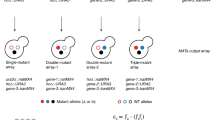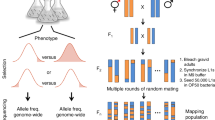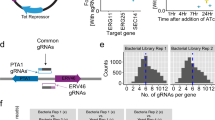Abstract
We describe a protocol for performing RNA interference (RNAi) screens in Caenorhabditis elegans in liquid culture in 96-well plates. The procedure allows a single researcher to set-up and score RNAi experiments at ∼2,000 genes per day. By comparing RNAi phenotypes between wild-type worms and worms carrying a defined genetic mutation, we have used this protocol to identify synthetic lethal interactions between genes systematically. We also describe how the protocol can be adapted to target two genes simultaneously by combinatorial RNAi.
This is a preview of subscription content, access via your institution
Access options
Subscribe to this journal
Receive 12 print issues and online access
$259.00 per year
only $21.58 per issue
Buy this article
- Purchase on Springer Link
- Instant access to full article PDF
Prices may be subject to local taxes which are calculated during checkout


Similar content being viewed by others
References
Timmons, L. & Fire, A. Specific interference by ingested dsRNA. Nature 395, 854 (1998).
Kamath, R.S. et al. Systematic functional analysis of the Caenorhabditis elegans genome using RNAi. Nature 421, 231–237 (2003).
Lehner, B., Fraser, A.G. & Sanderson, C.M. Technique review: how to use RNA interference. Brief Funct. Genomic Proteomic 3, 68–83 (2004).
Lehner, B., Crombie, C., Tischler, J., Fortunato, A. & Fraser, A.G. Systematic mapping of genetic interactions in Caenorhabditis elegans identifies common modifiers of diverse signaling pathways. Nat. Genet. 38, 896–903 (2006).
van Haaften, G., Vastenhouw, N.L., Nollen, E.A., Plasterk, R.H. & Tijsterman, M. Gene interactions in the DNA damage-response pathway identified by genome-wide RNA-interference analysis of synthetic lethality. Proc. Natl. Acad. Sci. USA 101, 12992–12996 (2004).
Nollen, E.A. et al. Genome-wide RNA interference screen identifies previously undescribed regulators of polyglutamine aggregation. Proc. Natl. Acad. Sci. USA 101, 6403–6408 (2004).
Ahringer, J. (ed.) Reverse genetics. in WormBook (ed. The C. elegans Research Community) (http://www.wormbook.org, 2006).
Tischler, J., Lehner, B., Chen, N. & Fraser, A.G. Combinatorial RNA interference in C. elegans reveals that redundancy between gene duplicates can be maintained for more than 80 million years of evolution. Genome Biol. 7, R69 (2006).
Simmer, F. et al. Loss of the putative RNA-directed RNA polymerase RRF-3 makes C. elegans hypersensitive to RNAi. Curr. Biol. 12, 1317–1319 (2002).
Kennedy, S., Wang, D. & Ruvkun, G. A conserved siRNA-degrading RNase negatively regulates RNA interference in C. elegans. Nature 427, 645–649 (2004).
Wang, D. et al. Somatic misexpression of germline P granules and enhanced RNA interference in retinoblastoma pathway mutants. Nature 436, 593–597 (2005).
Lehner, B. et al. Loss of LIN-35, the Caenorhabditis elegans of the tumor suppressor p105Rb, results in enhanced RNA interference. Genome Biol. 7, R4 (2006).
Acknowledgements
We thank the C. elegans Genetics Center for providing strains. B.L. was supported by a Sanger Institute Postdoctoral Fellowship. J.T., A.F. and A.G.F. were supported by the Wellcome Trust.
Author information
Authors and Affiliations
Corresponding author
Ethics declarations
Competing interests
The authors declare no competing financial interests.
Rights and permissions
About this article
Cite this article
Lehner, B., Tischler, J. & Fraser, A. RNAi screens in Caenorhabditis elegans in a 96-well liquid format and their application to the systematic identification of genetic interactions. Nat Protoc 1, 1617–1620 (2006). https://doi.org/10.1038/nprot.2006.245
Published:
Issue Date:
DOI: https://doi.org/10.1038/nprot.2006.245
This article is cited by
-
Paeoniflorin increases the survival of Pseudomonas aeruginosa infected Caenorhabditis elegans at the immunosuppression stage by activating PMK-1, BAR-1, and EGL-1 signals
Archives of Pharmacal Research (2023)
-
High-throughput small molecule screen identifies inhibitors of microsporidia invasion and proliferation in C. elegans
Nature Communications (2022)
-
Modifier pathways in polyglutamine (PolyQ) diseases: from genetic screens to drug targets
Cellular and Molecular Life Sciences (2022)
-
Betaine-rich sugar beet molasses protects from homocysteine-induced reduction of survival in Caenorhabditis elegans
European Journal of Nutrition (2020)
-
Inhibition of mitophagy decreases survival of Caenorhabditis elegans by increasing protein aggregation
Molecular and Cellular Biochemistry (2019)
Comments
By submitting a comment you agree to abide by our Terms and Community Guidelines. If you find something abusive or that does not comply with our terms or guidelines please flag it as inappropriate.



